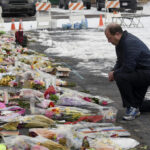
(Recasts, adds Guangzhou easing of curbs, analyst comment)
*
Riot police in hazmat suits clash with protesters
*
Estimated 27-43 protests in 22 cities across China
*
One of biggest acts of public defiance in a decade
*
Authorities probing protesters as security tightens
By Brenda Goh and Martin Quin Pollard
SHANGHAI/BEIJING, Nov 30 (Reuters) –
People in the Chinese city of Guangzhou clashed with riot police in hazmat suits on Tuesday night as authorities investigated more of those who have taken part in a string of protests against the world’s toughest COVID-19 restrictions.
The demonstrations, which escalated over the weekend as they spread to Shanghai, Beijing and
elsewhere
, are one of
the biggest acts of public defiance
seen since President Xi Jinping came to power in 2012.
The southern city of Guangzhou became the latest to announce an easing of curbs on Wednesday, but with record numbers of cases nationwide, there seems little prospect of a major U-turn in a policy that Xi has said is saving lives and has proclaimed
as one of his political achievements
.
Announcing the lifting of lockdowns in parts of Guangzhou, authorities did not mention the protests and the district where Tuesday’s violence flared remained under the tight controls.
In one video of those clashes posted on Twitter, dozens of riot police clad in white protective suits and holding shields over their heads, advanced in formation over what appeared to be torn down lockdown barriers as objects flew at them.
Police were later seen escorting away a row of people in handcuffs.
Another video clip showed people throwing objects at the police, while a third showed a tear gas canister landing amidst a small crowd on a narrow street, sending people running off to escape the fumes.
Reuters verified that the videos were filmed in Guangzhou’s Haizhu district, the scene of COVID-related unrest two weeks ago, but could not determine when the clips were taken or the exact sequence of events and what sparked the clashes.
Social media posts said the clashes took place on Tuesday night and were caused by a dispute over lockdown curbs.
The government of Guangzhou did not immediately respond to a request for comment.
China Dissent Monitor, run by U.S. government-funded Freedom House, estimated at least 27 demonstrations took place across China from Saturday to Monday. Australia’s ASPI think tank estimated 43 protests in 22 cities.
EASING CURBS
As well as the easing of curbs in Guangzhou, in Zhengzhou, the site of a big Foxconn factory making Apple iPhones that has been the scene of worker unrest over COVID, officials announced the “orderly” resumption of businesses, including supermarkets, gyms and restaurants.
However, they also published a long list of buildings that would remain under lockdown.
Hours before those announcements, national health officials said China would respond to “urgent concerns” raised by the public and that COVID rules should be implemented more flexibly, according to a region’s conditions.
But while the easing of some measures appears to be an attempt to appease the public, authorities have also begun to seek out those who have been at the protests.
“Police came to my front door to ask me about it all and get me to complete a written record,” a Beijing resident who declined to be identified told Reuters on Wednesday.
Another resident said some friends who posted videos of protests on social media were taken to a police station and asked to sign a promise they “would not do that again”.
Several people gave similar accounts to Reuters on Tuesday.
It was not clear how authorities identified the people they wanted to question, nor how many such people authorities contacted.
Beijing’s Public Security Bureau did not comment.
Analysts at the Economist Intelligence Unit said in a note that authorities would likely respond to the protests with heightened security while emphasising plans to loosen restrictions “all the while avoiding depicting itself as having conceded to the demands of the protesters”.
‘HOSTILE FORCES’
In a statement that did not refer to the protests, the Communist Party’s top body in charge of law enforcement agencies said late on Tuesday that China would resolutely crack down on “the infiltration and sabotage activities of hostile forces”.
The Central Political and Legal Affairs Commission also said “illegal and criminal acts that disrupt social order” would not be tolerated.
The foreign ministry has said rights and freedoms must be exercised within the law.
COVID has spread despite China largely isolating itself from the world and demanding significant sacrifices from hundreds of millions to comply with relentless testing and prolonged isolation, three years into the pandemic.
While infections and death numbers are low by global standards, analysts say that a reopening before increasing vaccination rates could lead to widespread illness and deaths and overwhelm hospitals.
The lockdowns have hammered the economy, disrupting global supply chains and roiling financial markets.
Data on Wednesday showed China’s manufacturing and services activity for November posting the lowest readings since Shanghai’s two-month lockdown began in April.
Chinese stocks were steady, with markets weighing endemic economic weakness against hopes that the public pressure could push China to eventually reopen.
International Monetary Fund chief Kristalina Georgieva flagged a possible downgrade in China’s growth forecasts.
(Additional reporting by Eduardo Baptista and Yew Lun Tian in Beijing; Writing by Marius Zaharia and John Geddie; Editing by Michael Perry, Robert Birsel)




